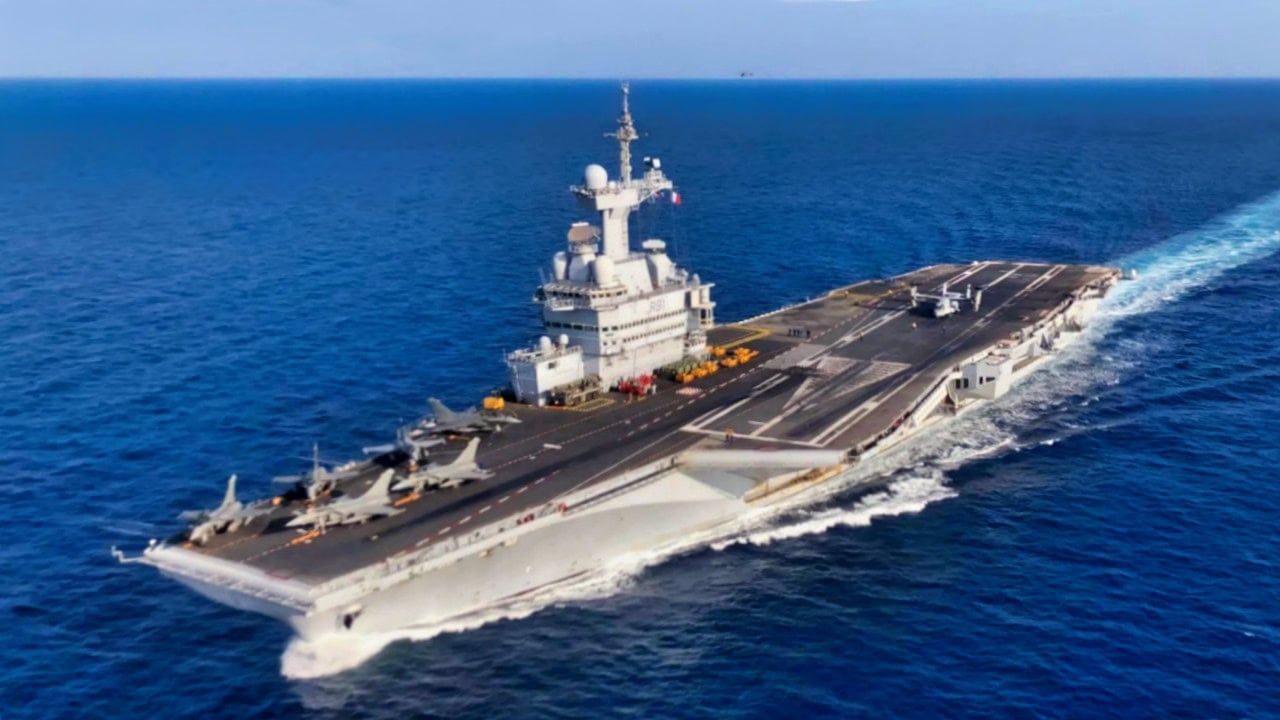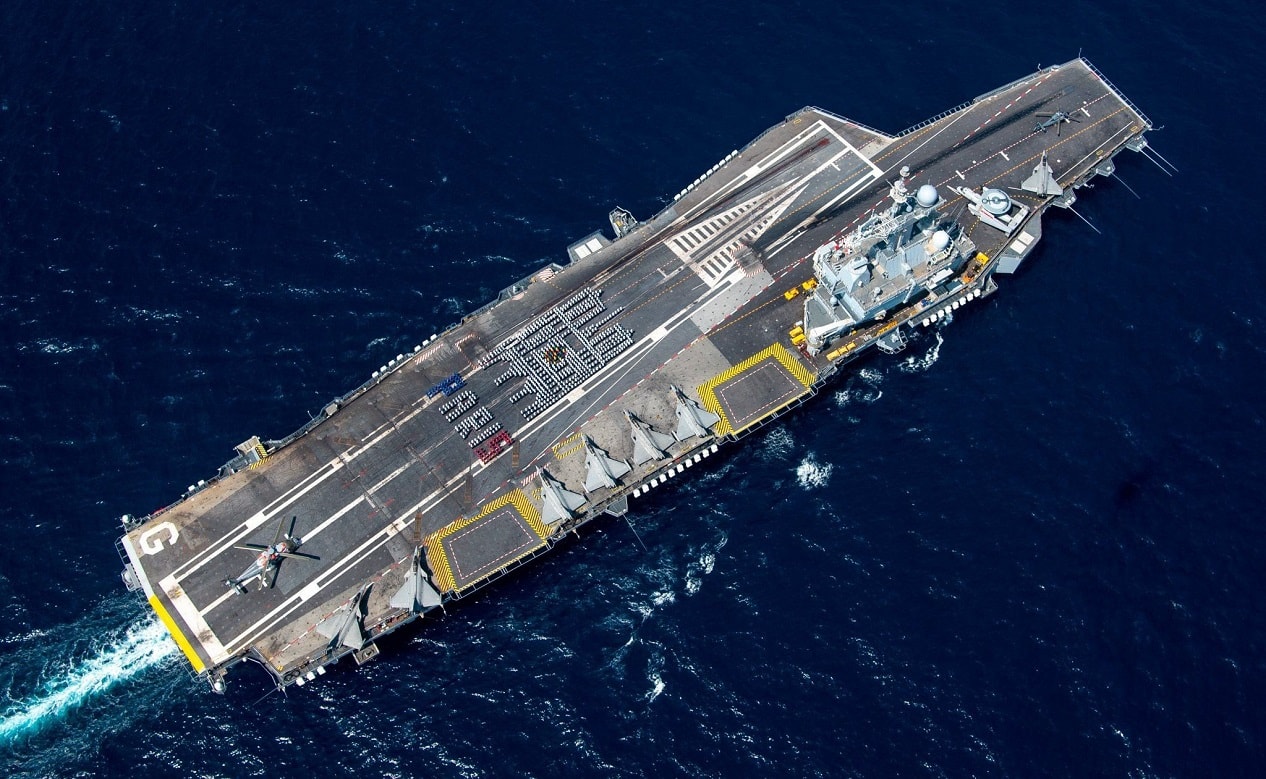Key Points and Summary: The USS Carl Vinson and FS Charles De Gaulle have ramped up joint exercises in the Indo-Pacific, signaling a strong allied presence against China.
-The US Navy conducted drills with the Philippines and Malaysia while patrolling the South China Sea, prompting a reaction from China’s military.
-Meanwhile, France led the La Perouse 25 exercise with eight Indo-Pacific nations, reinforcing maritime security and collective defense.
-With new US fighter deployments to Japan and bombers arriving in Guam, tensions are rising.
-As Beijing scrambles, the US and its allies remain committed to a free and open Indo-Pacific.
USS Carl Vinson and French Aircraft Carrier De Gaulle Flex Naval Power Near China
The US aircraft carrier USS Carl Vinson (CVN-70) wrapped up joint exercises in the South China Sea and made a port call to Thailand. Meanwhile, a French carrier group with the carrier FS Charles De Gaulle (R91) finished joint exercises in the Bali Sea.
These events had the Chinese scrambling as the PLA’s Southern Theater Command carried out maritime and air readiness patrols “in a bid to maintain peace and stability in the South China Sea region,” according to a China Military Online report.
Beijing claimed nearly the entirety of the South China Sea, marked by a “nine-dash line” on maps. This boundary encompasses the Paracel Islands, the Spratly Islands, and Scarborough Shoal, effectively claiming most of the sea’s islands and reefs. However, other countries in the region, such as Vietnam, Malaysia, and the Philippines, highly contest this claim.
The US Continues Partnerships In Indo-Pacific
The US Navy is responding to Chinese and North Korean bellicose actions and has repeatedly stated that it intends to protect the shipping lanes. With the Chinese trying to intimidate US allies in the region, the US Navy has increased its presence in the South China Sea.
The USS Carl Vinson’s deployment has included exercises and visits to US partners. Earlier this month, the carrier group participated in wargames in the Philippines. It happened to be that the USS Vinson’s arrival coincided with the Chinese “monster ship” off Zambales.
The carrier strike group trained alongside Filipino BRP Antonio Luna and BRP Andres Bonifacio, two FA-50 fighter aircraft, and Philippine Air Force Search & Rescue assets.
Following that, the carrier sailed in the South China Sea, where, on January 21, it conducted flight operations with EA-18 Growler aircraft.
The Growler is a modified F/A-18 Super Hornet aircraft. It is the most advanced airborne electronic attack (AEA) platform and the only one in production today. The Growler provides tactical jamming and electronic protection to US military forces and allies worldwide.
While patrolling in the Gulf of Thailand, aircraft from the Vinson carrier strike group trained with the Royal Malaysian Air Force over Peninsular Malaysia.
On January 27, the USS Carl Vinson arrived at Port Laem Chabang, Thailand. The Navy released an official statement stating the arrival. It noted, “The visit demonstrates the continuation of a long-standing partnership among allied countries rooted in close people-to-people, economic, and security ties. Vinson, the flagship of Carrier Strike Group ONE, is currently pier-side in Laem Chabang, Thailand, for a scheduled port visit.”
More US Moves In the Indo-Pacific
The US is making China aware of its naval power to counter threatening Chinese behavior. Newsweek reported that US RC-135 reconnaissance aircraft flew several spying missions near the coast of China this month, according to Newsweek’s map, using open-source tracking data.
The U.S. Pacific Air Forces (PACAF) previously told Newsweek that the RC-135 aircraft were conducting “planned, routine operations” in the Indo-Pacific region.
In December, a US Navy P-8 Poseidon spy plane flew over the Taiwan Strait as part of its Freedom of Navigation Operation (FONOP), triggering Chinese protest for the US “provocation,” which claims Taiwan as its sovereign territory. A similar P-8 flight was undertaken in November 2024.

U.S. 5TH FLEET AREA OF OPERATIONS (April 24, 2019) A U.S. Marine MV-22 Osprey assigned to the 22nd Marine Expeditionary Unit sits on the flight deck of France’s Marine Nationale aircraft carrier FS Charles De Gaulle (R 91). This was the second time that Ospreys have landed aboard the French vessel. Marines and Sailors assigned to the 22nd MEU and Kearsarge Amphibious Ready Group are currently deployed to the U.S. 5th Fleet area of operations in support of naval operations to ensure maritime stability and security in the Central region, connecting the Mediterranean and the Pacific through the western Indian Ocean and three strategic choke points. (U.S. Marine Corps photo by Maj. Joshua Smith/Released)
Meanwhile, on January 13, the US Air Force dispatched F-35A Lightning II fighters assigned to the 134th Expeditionary Fighter Squadron, Vermont Air National Guard, to the Kadena Air Base in Okinawa, Japan. Okinawa is located only 200 miles from Taiwan.
The Air Force dispatched four B-1B bombers to Guam, and the Navy sent the Los Angeles-class fast-attack submarine USS Columbia, which entered the Apra Harbor, Naval Base Guam on January 12.
The Navy released a statement, clearly telegraphing the sub was there with a thumbing a nose at China. “Columbia is on deployment supporting the U.S. 7th Fleet, the U.S. Navy’s largest forward-deployed numbered fleet, operating with allies and partners in preserving a free and open Indo-Pacific region,” the Command said.
China Is Watching: French Carrier De Gaulle Carries Out Exercises
The French Navy conducted power projection in the region. The French FS Charles De Gaulle (R91) carrier strike group, which included destroyer FS Forbin (D620), frigates FS Provence (D652) and FS Alsace (D656), fleet oiler FS Jacques Chevallier (A725) and a nuclear-powered attack submarine wrapped the La Perouse 25 exercise.

Nimitz-class aircraft carrier USS Carl Vinson (CVN 70) transits the Bay of Bengal as part of Maritime Partnership Exercise (MPX), Oct. 16, 2021. MPX 2021 is a multilateral maritime exercise between the Royal Australian Navy, Japan Maritime Self-Defense Force, U.K. Royal Navy, and U.S. maritime forces, focused on naval cooperation, interoperability and regional security and stability in the Indo-Pacific and is an example of the enduring partnership between Australian, Japanese, U.K. and U.S. maritime forces, who routinely operate together in the Indo-Pacific, fostering a cooperative approach toward regional security and stability. (U.S. Navy photo by Mass Communication Specialist 2nd Class Russell Lindsey)
The exercise was conducted with eight other Indo-Pacific nations: Australia, Canada, the United States, India, Indonesia, Malaysia, the United Kingdom, and Singapore. The exercise involved 13 vessels operating in the Indian and Pacific Oceans.
The French-led exercise aimed to enhance maritime security, develop interoperability, and build collective crisis response capabilities. It also clearly signaled that France would continue to grow its commitment to the Indo-Pacific region.

The Nimitz-class aircraft carrier USS Carl Vinson (CVN 70) transits the Philippine Sea with six additional F-35C Lightning II aircraft assigned to the “Argonauts” of Strike Fighter Squadron (VFA) 147, part of Carrier Air Wing FIVE, Dec. 13, 2024. VFA-147 operates from Marine Corps Air Station Iwakuni, Japan. U.S. Indo-Pacific Command forces perform operations in and around critical sea passages and trade thoroughfares to deter threats that create regional instability and impinge on the free flow of goods, people, and ideas. (U.S. Navy photo by Mass Communication Specialist Seaman Apprentice Pablo Chavez)
The heat is building up in the region, but the US, France, and our collective allies are not going to allow China just to bully nations in the Indo-Pacific.
About the Author:
Steve Balestrieri is a 19FortyFive National Security Columnist. He served as a US Army Special Forces NCO and Warrant Officer. In addition to writing for 1945, he covers the NFL for PatsFans.com and is a member of the Pro Football Writers of America (PFWA). His work was regularly featured in other military publications.

